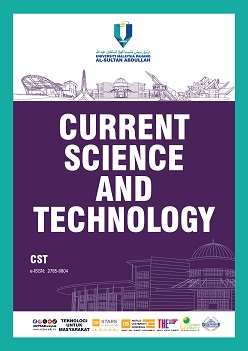Impact of Storage Temperature and Duration on Ethanol Content in Juice and Soft Drinks
DOI:
https://doi.org/10.15282/cst.v3i2.10285Keywords:
Ethanol, Gas chromatography, Beverages, Storage time, TemperatureAbstract
The ethanol content in beverages can be impacted by storage conditions, presenting potential implications for product quality and consumer safety. The study examined the impact of storage temperature and duration on ethanol levels in various beverages, including sugarcane juice, grape juice, and soft drinks. The findings suggest that storage conditions significantly influence ethanol production, particularly in sugarcane juice. Storing sugarcane juice at 28°C for 14 days resulted in a substantial increase in ethanol content, from 2.11% to 7.32% alcohol by volume (ABV). In contrast, grape juice exhibited moderate ethanol increases, and soft drinks showed minimal changes, with ethanol peaking at 0.95% ABV. These results highlight the accelerated fermentation process in sugarcane juice under higher temperatures and underline the importance of maintaining strict storage conditions to preserve beverage quality. Comparative analysis indicates that sugarcane juice is highly susceptible to ethanol generation when stored at room temperature, emphasizing the necessity of refrigeration to maintain its safety and flavor profile.
References
[1] S. K. Tulashie, A. P. Appiah, G. D. Torku, A. Y. Darko, and A. Wiredu, “Determination of methanol and ethanol concentrations in local and foreign alcoholic drinks and food products (Banku, Ga kenkey, Fante kenkey and Hausa koko) in Ghana,” International Journal of Food Contamination, vol. 4, no. 1, pp. 1-5, 2017.
[2] R. Gao, L. Xiong, M. Wang, F. Peng, H. Zhang, and X. Chen, “Production of acetone-butanol-ethanol and lipids from sugarcane molasses via coupled fermentation by Clostridium acetobutylicum and oleaginous yeasts,” Industrial Crops and Products, vol. 185, p. 115131, 2022.
[3] J. Yang, L. Zhang, T. Wang, J. Zhang, M. Li, X. Jin, et al., “Synergistic effects of combined treatment of 1,2-dichloroethane and high-dose ethanol on liver damage in mice and the related mechanisms,” Food and Chemical Toxicology, vol. 176, p. 113812, 2023.
[4] M. L. Martel, L. R. Klein, A. J. Lichtenheld, A. M. Kerandi, B. E. Driver, and J. B. Cole, “Etiologies of altered mental status in patients with presumed ethanol intoxication,” American Journal of Emergency Medicine, vol. 36, no. 6, pp. 1057–1059, 2018.
[5] F. Wan, S. Liu, L. Wang, and S. Si, “A novel salting-out extraction system for determination of ethylene glycol and diethylene glycol in liquid samples followed by GC-FID,” Microchemical Journal, vol. 179, p. 107491, 2022.
[6] C. L. dos Santos Costa, D. P. Ramos, and J. B. da Silva, “Multivariate optimization and validation of a procedure to direct determine acetonitrile and ethanol in radiopharmaceuticals by GC-FID,” Microchemical Journal, vol. 147, pp. 654–659, 2019.
[7] C. K. Attchelouwa, F. K. N’guessan, S. Marcotte, T. L. S. Amoikon, M. Charmel, and M. K. Djè, “Characterisation of volatile compounds associated to sensory changes during the storage of traditional sorghum beer by HS-GC/FID and SPME-GC/MS,” Journal of Agriculture and Food Research, vol. 2, p. 100088, 2020.
[8] M. Różański, K. Pielech-Przybylska, and M. Balcerek, “Influence of alcohol content and storage conditions on the physicochemical stability of spirit drinks,” Foods, vol. 9, no. 9, p. 1264, 2020.
[9] A. R. Mansur, J. Oh, H. S. Lee, and S. Y. Oh, “Determination of ethanol in foods and beverages by magnetic stirring-assisted aqueous extraction coupled with GC-FID: A validated method for halal verification,” Food Chemistry, vol. 366, p. 130526, 2022.
[10] M. Yilmaztekin, T. Cabaroglu, and H. Erten, “Effects of fermentation temperature and aeration on production of natural isoamyl acetate by williopsis saturnus var. saturnus,” BioMed Research International, vol. 2013, p. 870802, 2013.
[11] H. T. Kim, E. J. Yun, D. Wang, J. H. Chung, I. G. Choi, and K. H. Kim, “High temperature and low acid pretreatment and agarase treatment of agarose for the production of sugar and ethanol from red seaweed biomass,” Bioresource Technology, vol. 136, pp. 582–587, 2013.
[12] A. F. Danelon, H. F. S. Spolador, and J. S. Bergtold, “The role of productivity and efficiency gains in the sugar-ethanol industry to reduce land expansion for sugarcane fields in Brazil,” Energy Policy, vol. 172, p. 113327, 2023.
[13] M. L. Cazetta, M. A. P. C. Celligoi, J. B. Buzato, and I. S. Scarmino, “Fermentation of molasses by Zymomonas mobilis: Effects of temperature and sugar concentration on ethanol production,” Bioresource Technology, vol. 98, no. 15, pp. 2824–2828, 2007.
[14] F. Mehdi, S. Galani, K. P. Wickramasinghe, P. Zhao, X. Lu, X. Lin et al., “Current perspectives on the regulatory mechanisms of sucrose accumulation in sugarcane,” Heliyon, vol. 10, no. 5, p. e27277, 2024.
[15] M. Aghbashlo, M. Tabatabaei, and K. Karimi, “Exergy-based sustainability assessment of ethanol production via Mucor indicus from fructose, glucose, sucrose and molasses,” Energy, vol. 98, pp. 240–252, 2016.
[16] J. yil Park, E. Kanda, A. Fukushima, K. Motobayashi, K. Nagata, M. Kondo, et al., “Contents of various sources of glucose and fructose in rice straw, a potential feedstock for ethanol production in Japan,” Biomass Bioenergy, vol. 35, no. 8, pp. 3733–3735, 2011.
[17] J. Echave, M. Barral, M. Fraga-Corral, M. A. Prieto, and J. Simal-Gandara, “Bottle aging and storage of wines: A review,” Molecules, vol. 26, no. 3, p. 713, 2021.
[18] S. K. Amit, M. M. Uddin, R. Rahman, S. M. R. Islam, and M. S. Khan, “A review on mechanisms and commercial aspects of food preservation and processing,” Agriculture & Food Security, vol. 6, pp. 1-22, 2017.
[19] S. Madhania, Y. Muharam, S. Winardi, and W. W. Purwanto, “Mechanism of molasses–water mixing behavior in bioethanol fermenter. Experiments and CFD modeling,” Energy Reports, vol. 5, pp. 454–461, 2019.
[20] R. Sharma, P. Garg, P. Kumar, S. K. Bhatia, and S. Kulshrestha, “Microbial fermentation and its role in quality improvement of fermented foods,” Fermentation, vol. 6, no. 4, p. 106, 2020.
Downloads
Published
Issue
Section
License
Copyright (c) 2023 The Author(s)

This work is licensed under a Creative Commons Attribution-NonCommercial 4.0 International License.



